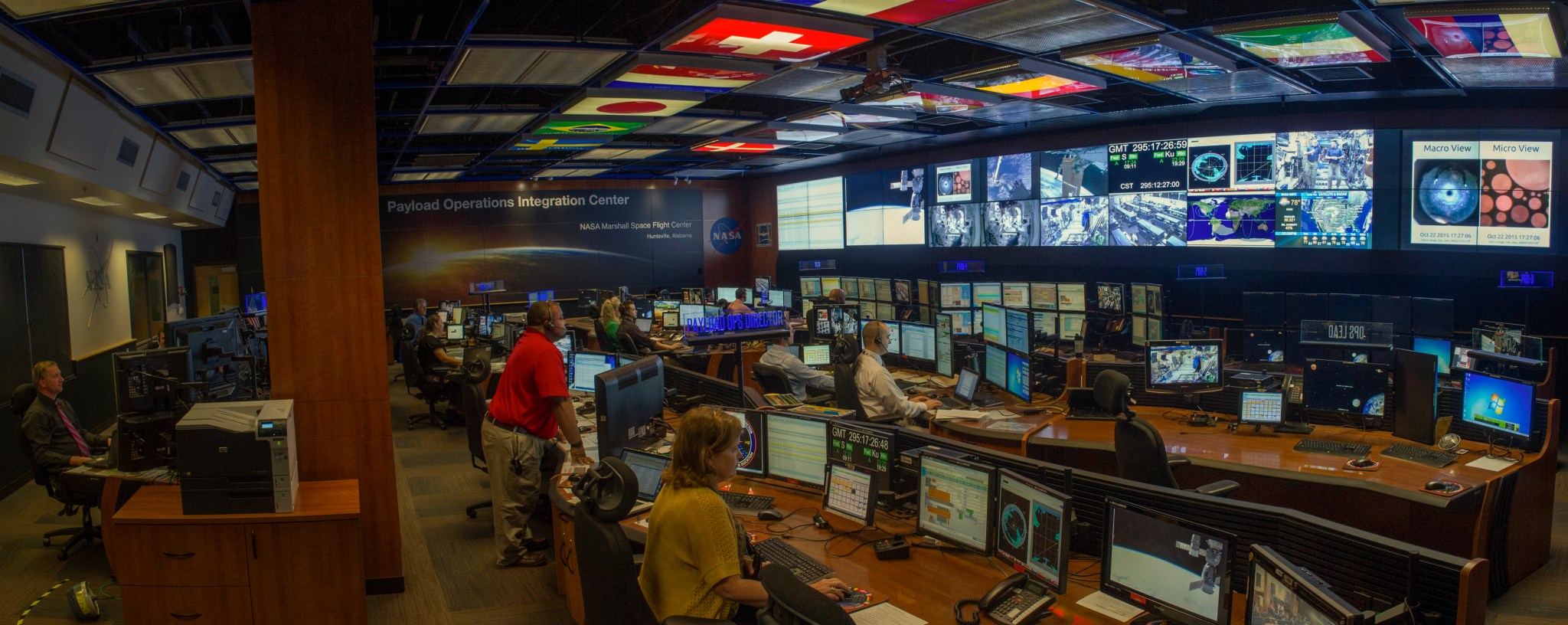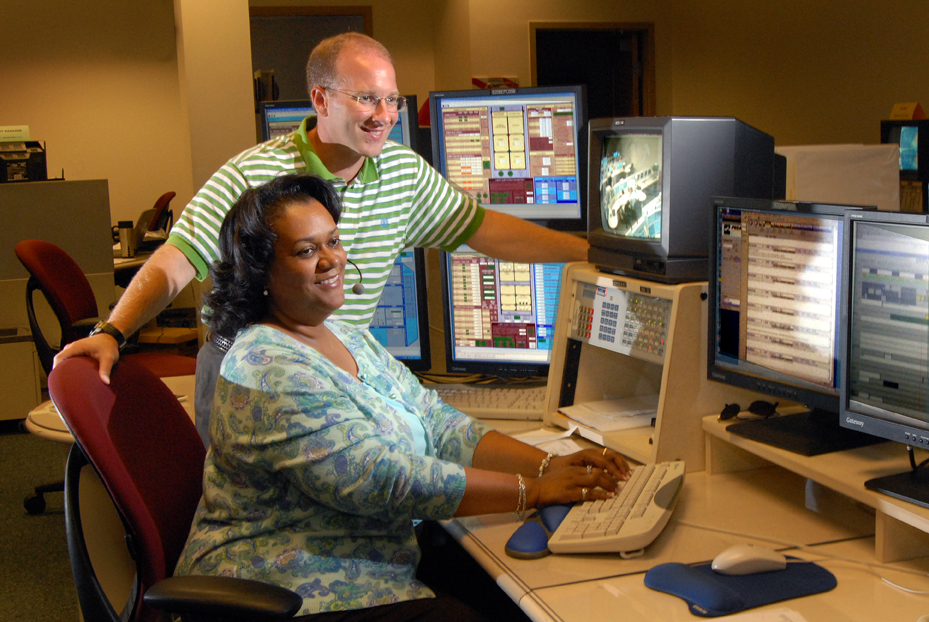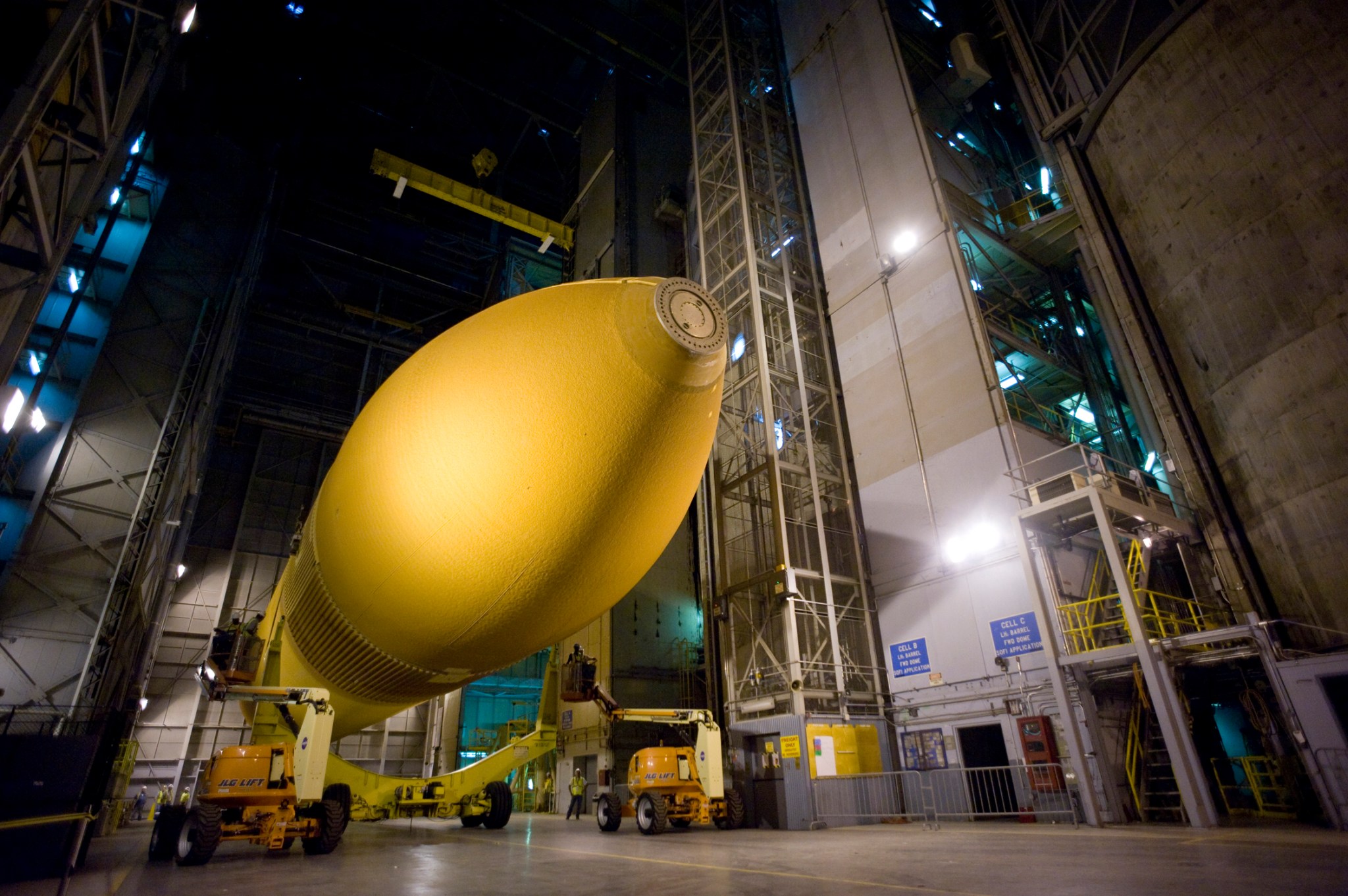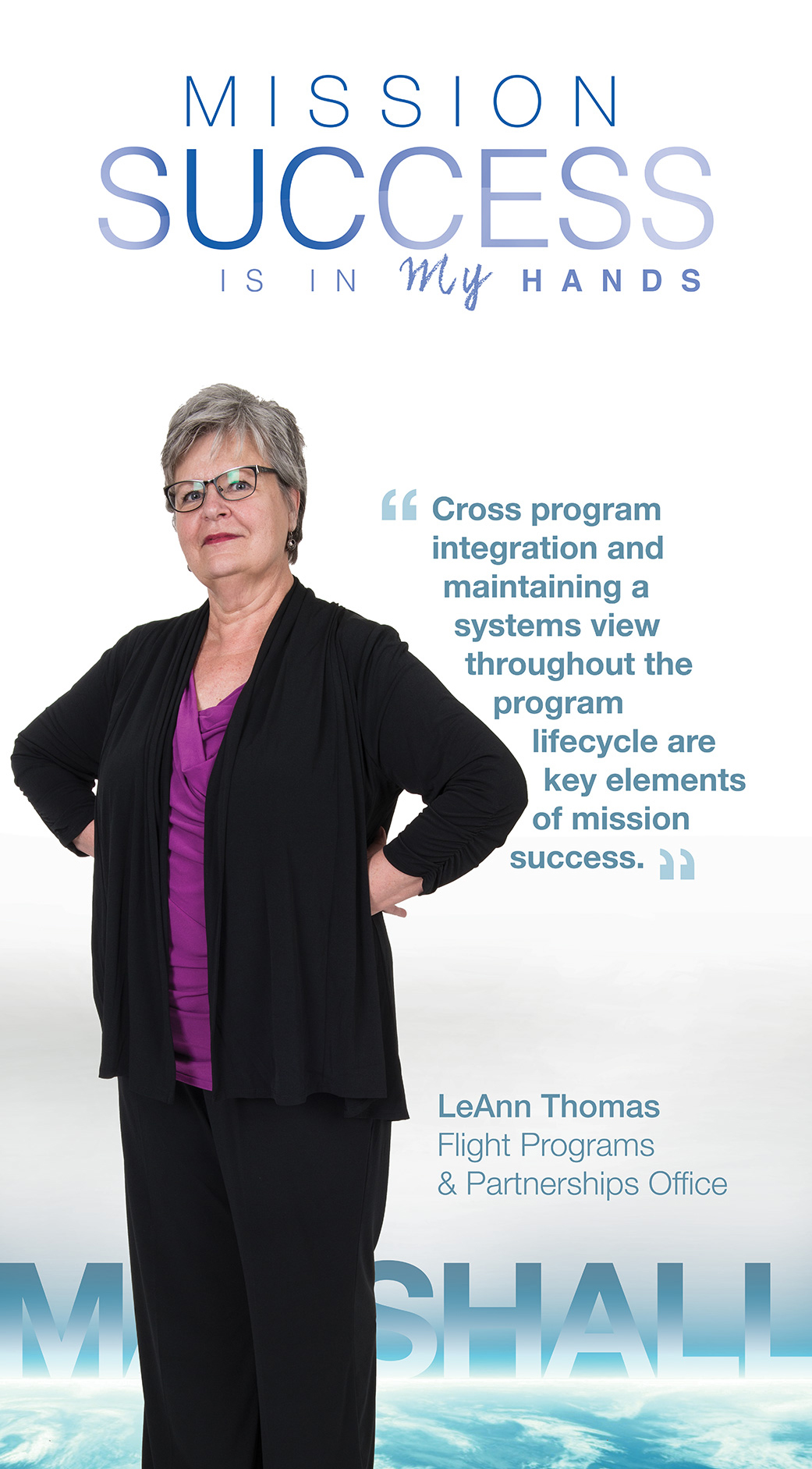In This Week’s Star
- Marshall Center Team Marks 15 Years of Making Science Happen on the International Space Station
- NASA Honors 12 Marshall Team Members with Silver Snoopy Award
- External Tank 94 to Join Space Shuttle Endeavour in Los Angeles
- Marshall CFC Volunteers Change Lives at the Downtown Rescue Mission
- Mission Success Is in My Hands: Q&A with Leann Thomas
- Mars Exploration Exhibit Opens at St. Louis Science Center
- This Week in NASA History: Apollo 12 Astronauts Return to Earth After Successful Moon Landing — Nov. 24, 1969
- Welding of Orion Spacecraft at Michoud Assembly Facility Featured on ‘This Week @NASA’
- Obituaries
Marshall Center Team Marks 15 Years of Making Science Happen on the International Space Station
By Bill Hubscher
Humans have been living and working on an orbiting laboratory longer than many high school students have been alive. This month marks 15 years of continuous human presence on the International Space Station.
When the first crew docked with the station for Expedition 1, the science control center at NASA’s Marshall Space Flight Center was staffed and ready to support the first experiments. Back then, a smaller station and a crew of only three people meant a small team on the ground compared to today. Figuring out how to support science around-the-clock and create the control room required late nights and a new way of thinking. This eventually paid off with the creation of the space station’s Payload Operation and Integration Center at Marshall — NASA’s science command post that started operating around the clock, 365 days a year in March 2001.
“We took on a monumental and fulfilling task,” said Lybrease Woodard, deputy director of the Mission Operations Laboratory, the Marshall engineering lab that manages the science center operations. She was one of the original payload operations directors for the POIC.
“We had staffed consoles and helped monitor 24-hour-a-day science during Spacelab and space shuttle missions, but those rarely lasted longer than three months at the most. This was going to be a science output 24 hours every day for the foreseeable future, with no breaks,” said Woodard. “This exponential growth was long-term planning at its finest, and we had the right team to make it happen.”
Drawing from the tremendous amount of experience gained during Spacelab science missions on NASA’s space shuttles, the science operations team at Marshall led the way through thousands of hours of planning to establish how science operations could be supported around the clock. The best methods for helping astronauts in orbit require extensive advance planning. Marshall team members have streamlined operations while working with crews on 45 expeditions.
“There were numerous processes we had to create,” said Lewis Wooten, director of the Mission Operations Laboratory. “We needed to determine the best way not only to train and inform astronauts in orbit about the dozens of experiments they could be juggling on any given day, but also the controllers on the ground. We found the right people and learned how to certify them for flight support.”
One of the key positions is the Payload Operations Director, or POD. This person coordinates everything happening with space station science in the control room and is part of the Flight Director’s team in the Mission Control Center at NASA’s Johnson Space Center. More than 40 payload operations directors have supported crews in space since 2000.
“What resonates most with me is the team aspect of working in the control room environment during real-time operations,” said Sam Digesu, manager of the Payload Operations Directors Office. “No matter which shift people work — middle of the day, weekends, overnight — it is the highly trained individuals in the control room who support each other in executing the procedures that return valuable scientific research data. There is a strong sense of team bonding and the flight controllers are like family.”
Speaking of families, support from home is very important to those in the POIC, especially during the holidays. During one Christmas season, Lamar Stacy — now the deputy chief of the Payload Operations Director’s office — needed to work a set of overnight shifts, but was still able to see his family.
“When I arrived home on Christmas morning, my family gathered around the tree and opened gifts, as is our tradition,” said Stacy. “Afterwards, the kids did their best to play quietly with their new toys while I got some sleep. I awoke that afternoon, had the customary feast and spent some quality time with my family before returning to the console at 10:30 p.m. Science doesn’t take a break for holidays.”
Earlier flight expeditions weren’t always so busy and there were fewer crew members on board the station, so, before turning in for the night, some astronauts enjoyed various forms of entertainment that involved the various ground control centers.
“Astronaut Greg Chamitoff would play chess against the entire team here, calling down a move every day,” said Bernd Billmayer, a payload communications officer at Marshall. “He was pretty good, so we started getting a little help from an Alabama chess champion who worked in the next building. On another expedition, astronauts Michael Lopez-Alegria and Suni Williams would play bits of songs for us to identify – it was Huntsville against Houston. One time I got talked into singing a few notes to Suni for an extra point. I can still hear them all laughing on board. But we won!”
The POIC team has helped the space station crews conduct more than 1,700 experiments from 83 countries around the world, and many are returning benefits for humanity as well as helping NASA prepare for missions even farther away from Earth.
Putting this infrastructure in place gives the agency a secondary benefit because it serves as a way to learn about preparing for major projects and the value of back-up systems when your outpost in space is still relatively close enough for resupply.
“The suite of command and control computers on the station had two hard drives fail and a third running in a degraded state,” recalled Howard Stetson, a computer scientist for the POIC in 2001. “Thankfully, the computers in orbit used to manage payload activities on the station were duplicates of that hardware and we had planned for a back-up computer to be stored on the station. We loaned it to the control side of the station until replacements could be launched. We learned how important this redundancy will be in the future because we won’t be able to launch resupply missions when we travel to deep space. Common hardware components will be critical.”
More information about the International Space Station’s 15 years in orbit can be found online at a special anniversary website. Follow this link for more stories of 15 years of science from the POIC.
Hubscher, an ASRC Federal/Analytical Services employee, supports the Office of Strategic Analysis & Communications.
NASA Honors 12 Marshall Team Members with Silver Snoopy Award
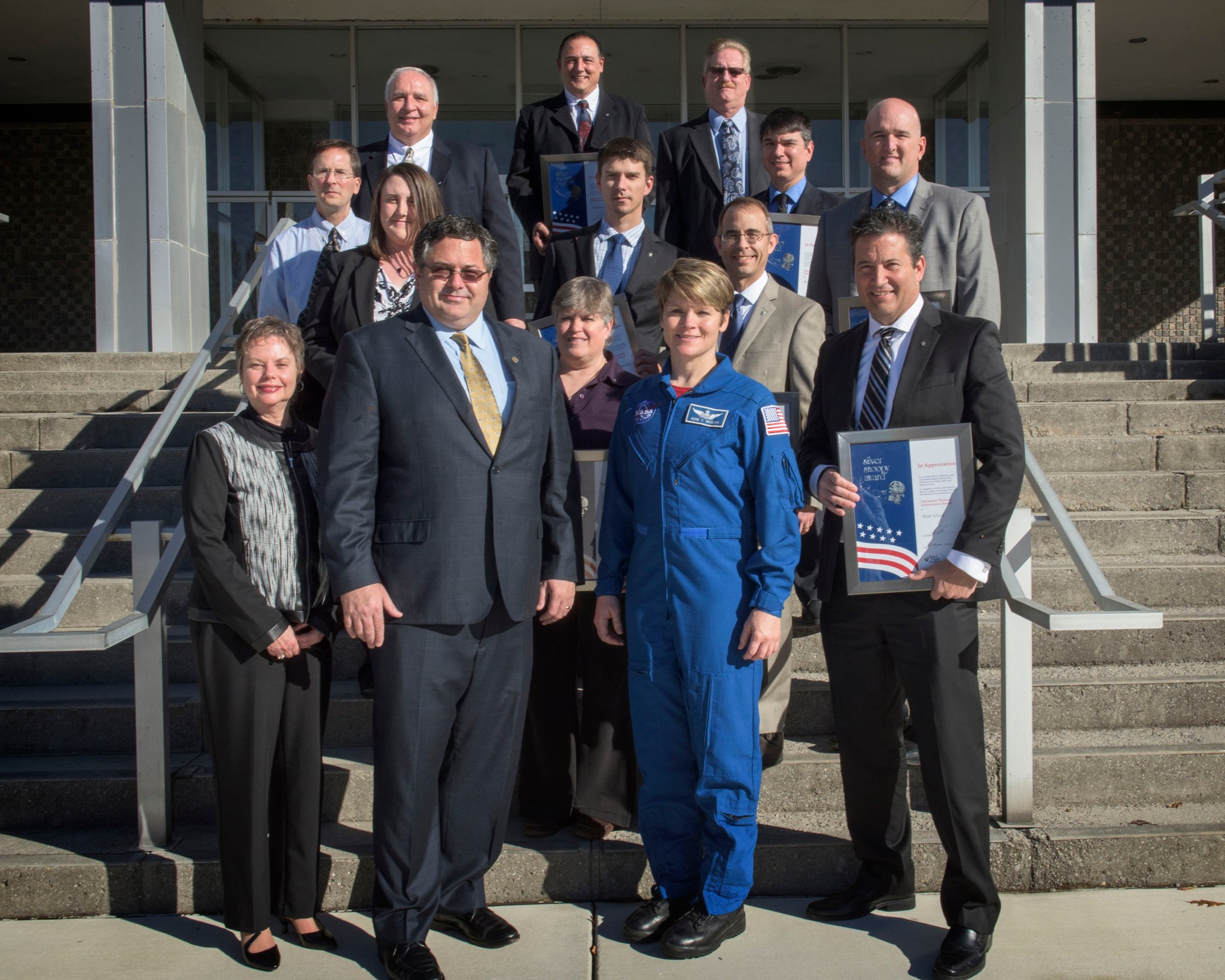
Astronaut Anne McClain presented NASA’s Silver Snoopy awards on Nov. 19 to 12 NASA Marshall Space Flight Center team members for their work to ensure mission success and flight safety. The award is presented personally by NASA astronauts as it represents the astronauts’ own recognition of excellence. Marshall Acting Director Todd May, (front, second from left) took part in the presentations. Marshall Silver Snoopy recipients were Donna Kaukler, Kent Schock, Danielle Moser, Cynthia Coker, Justin Rutledge, Michael Kovach, Mitchell Moore, Richard Boothe, Drew Hall, Tony Moore, Alvin Eidson and Steven Alford. For more information on the award, visit here.
External Tank 94 to Join Space Shuttle Endeavour in Los Angeles
By Brian C. Massey
In 2018, the California Science Center in Los Angeles will complete a collection few thought would ever be seen together again — an entire NASA space shuttle launch vehicle. Recently, NASA gave External Tank 94 to the California Science Center. There the tank will join space shuttle Endeavour and two solid rocket boosters to create a complete space shuttle stack.
The tank will travel to California from NASA’s Michoud Assembly Facility, where all the External Tanks were made for the Space Shuttle Program. They were the shuttle missions’ “gas tanks,” containing the propellants used by the Space Shuttle Main Engines, and were the only component of the shuttle that wasn’t reused. Approximately 8.5 minutes into flight, with its propellant exhausted, the external tank was jettisoned.
ET-94, a “Lightweight Tank,” is the only remaining External Tank. Before ET-94’s turn for launch came, it had been replaced by new “Super Lightweight Tank” technology, which reduced the weight by more than 7,000 pounds.
But ET-94 played an important role in NASA’s Return to Flight after the loss of the shuttle Columbia and the crew of STS-107. Shortly after liftoff, a piece of Thermal Protection System foam separated from External Tank 93, causing damage to Columbia’s left wing which ultimately lead to the shuttle’s disintegration upon reentry and the loss of all seven crew members. ET-94 had been built side-by-side with ET-93.
“Essentially, ET-94 was a full-scale test article, as close to ET-93 as possible,” said Steve Holmes, who served as the Non-Metallic Lead for the External Tank Project at NASA’s Marshall Space Flight Center during the Space Shuttle Program.
Marshall engineers dissected and analyzed ET-94 to determine what had caused the foam loss from its sister tank. “We took multiple dissections from the tank, to determine void size and frequency,” he said. “We never definitively determined what caused the foam from the bipod ramp to come off, so we used ET-94 as a test insulation article when the decision was made to remove the bipod ramp and redesign the fitting heating system.”
The bipod ramp was a foam ramp designed to reduce aerodynamic pressures and ice accumulation on the bipod, which connected the tank to the shuttle, during launch. Following Columbia Accident Investigation, the ramps were removed and additional heaters were added to prevent ice buildup.
In July 2005, 907 days after the loss of Columbia, NASA launched STS-114, the first Return to Flight mission, thanks largely to ET-94’s contributions. Outdated and dissected, however, space flight was not an option for ET-94.
Upon the conclusion of the space shuttle program, NASA transferred the shuttles to education institutions and museums. Space shuttle Atlantis is on display at the Kennedy Space Center Visitor Complex; Discovery resides in the Smithsonian Institution’s National Air and Space Museum in Chantilly, Virginia; and Enterprise is in New York City’s Intrepid Sea-Air-Space Museum.
With the addition of ET-94 in 2018, the California Science Center will have something none of the other institutions will — a complete launch system.
“It’s great that they’ll be able to complete the collection,” said Holmes, who is now the Manufacturing Lead for the Space Launch System’s Core Stage. “A full-up stack of a shuttle vehicle, complete with authentic flight hardware, will be quite a sight.”
For more information about the California Science Center’s display, click here.
Massey, an ASRC Federal/Analytical Services employee and the Marshall Star editor, supports the Office of Strategic Analysis & Communications.
Marshall CFC Volunteers Change Lives at the Downtown Rescue Mission
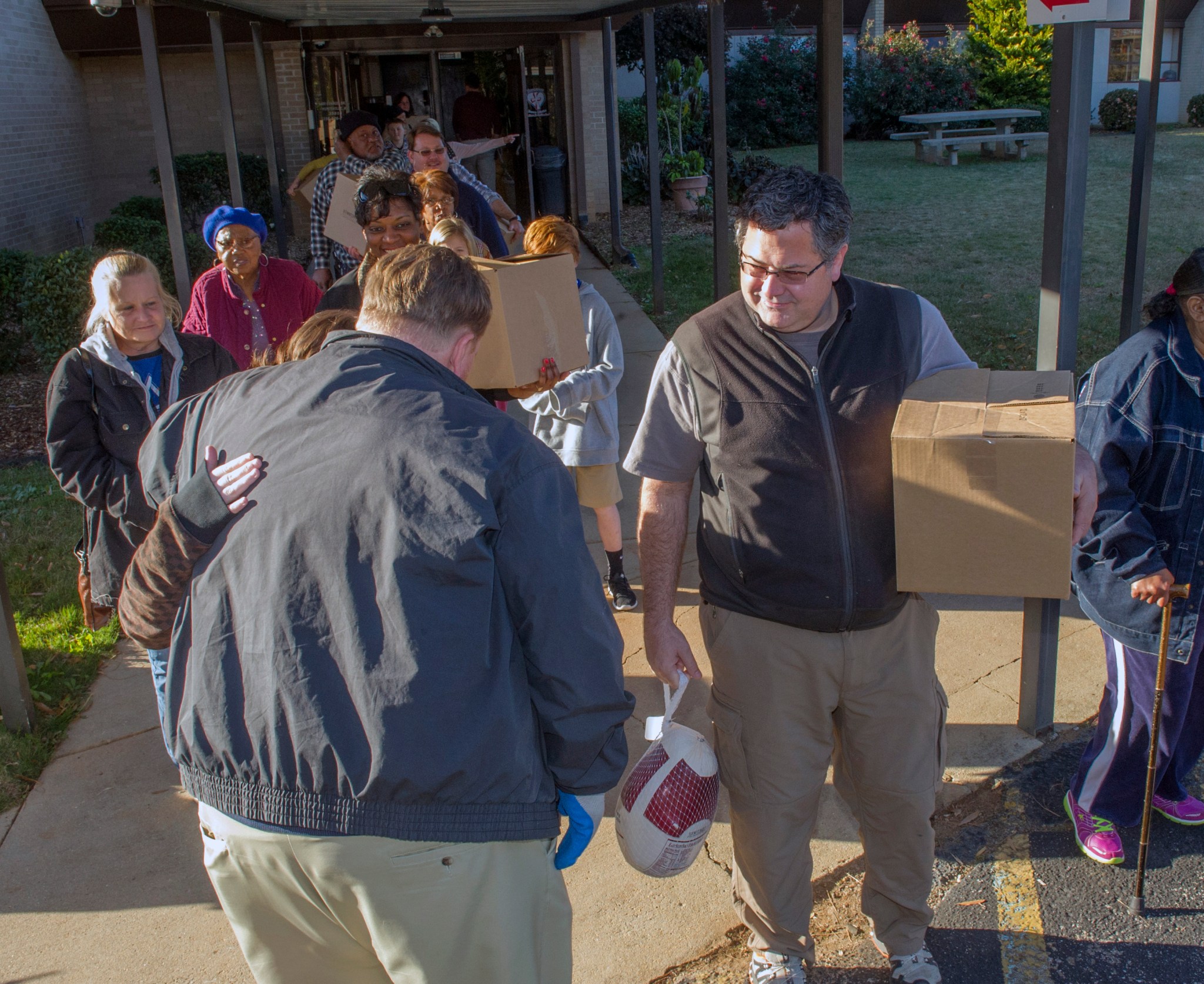
Acting Marshall Space Flight Center Director Todd May, right, along with other Marshall team volunteers, handed out turkeys at the Downtown Rescue Mission on Nov. 23 in preparation for the Thanksgiving holiday. The Downtown Rescue Mission is one of the many local charities that benefit from donations made by federal employees to the Combined Federal Campaign. With only three weeks left in the campaign, there is still time to donate and help reach Marshall’s goal of $650,000 by Dec. 15. Marshall team members can pledge online through Employee Express or request a paper pledge from your organization’s keyworker. To find your keyworker, visit the CFC community on ExplorNet by clicking here. (NASA/MSFC/Emmett Given)
Mission Success Is in My Hands: Q&A with Leann Thomas
Leann Thomas, of the Flight Programs and Partnerships Office at NASA’s Marshall Space Flight Center, recently talked with Marshall Public Affairs Officer Molly Porter about “Mission Success Is in Our Hands,” an initiative underway at Marshall to strengthen team members’ commitment to mission assurance and flight safety.
Years at Marshall: 30 years
What are the key responsibilities of your current job?
I currently serve as the Interfaces Functional Area Lead for the Exploration Systems Development — Cross-Program Systems Integration Organization. I’m responsible for functional integration of the cross-program interface activities and tasks within CSI and I report to the Cross-Program Integration Team leadership.
How does your work support the safety and success of NASA and Marshall missions?
Cross-program integration and maintaining a systems view throughout the program life cycle are key elements of mission success. I am fortunate to be able to work with talented teams across three programs — Ground Systems Development and Operations, Orion and Space Launch System. These teams demonstrate leadership, teamwork and integration across multiple disciplines in support of these programs.
What does “Mission Success Is in Our Hands” mean to you?
- Taking ownership in your product and the system.
- Contributing to your team. I have asked several people over the years about their favorite project. Interestingly, most people said that being part of a strong, supportive team is what they associate with their greatest accomplishments.
- Maintaining a systems view throughout the life cycle.
- Never making assumptions, always asking.
Do you have a story or personal experience you can share that might help others understand the significance of mission assurance or flight safety? What did you learn from it?
I have had the opportunity to learn from excellent systems engineers, functional managers and program managers. Early in my career, a senior manager told me, “It is always the simple interfaces that will get you. Everybody pays attention to the complex ones.” I took that advice and pushed for early compatibility testing on some “simple interfaces” on the program I was supporting, and we found two design issues early in the development phase that were corrected prior to flight hardware development.
A chief engineer that I learned much from also told me to always trust my instinct. If you aren’t comfortable, then there must be something you are missing. This advice gave me the courage to speak up during system testing and request additional testing. There was an intermittent problem that could’ve impacted the mission if it had not been isolated and the design modified.
I have always remembered these early lessons and applied these, and others, to all projects that I have supported.
How can we work together better to achieve mission success?
It may sound cliché, but I truly believe that strong teaming, listening to others and continuous integration are instrumental to mission success.
Mars Exploration Exhibit Opens at St. Louis Science Center
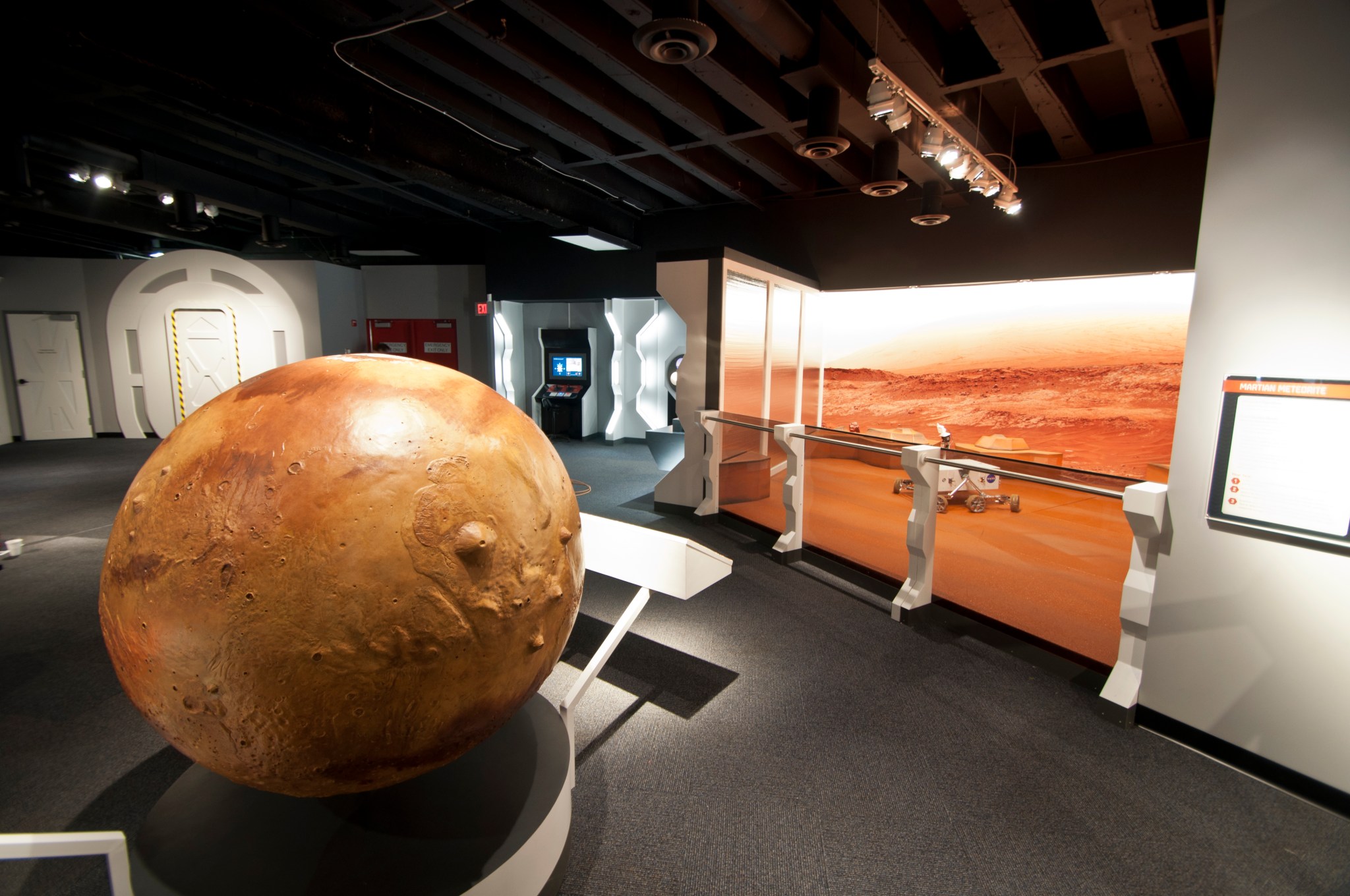
On Nov. 21, the Saint Louis Science Center in Saint Louis, Missouri, opened a new Mars-themed exhibit to inform, engage and inspire the public about NASA’s journey to Mars. The exhibit, built with grant funds awarded by NASA’s Office of Education, includes two Martian panoramic surfaces with replica Mars rovers. Each rover can be remotely controlled for real-time exploration of the exhibit’s simulated landscape. One control system includes a reduction in data and video transmissions designed to mimic the real-world time delay experienced during deep-space communications (St. Louis Science Center)
This Week in NASA History: Apollo 12 Astronauts Return to Earth After Successful Moon Landing — Nov. 24, 1969
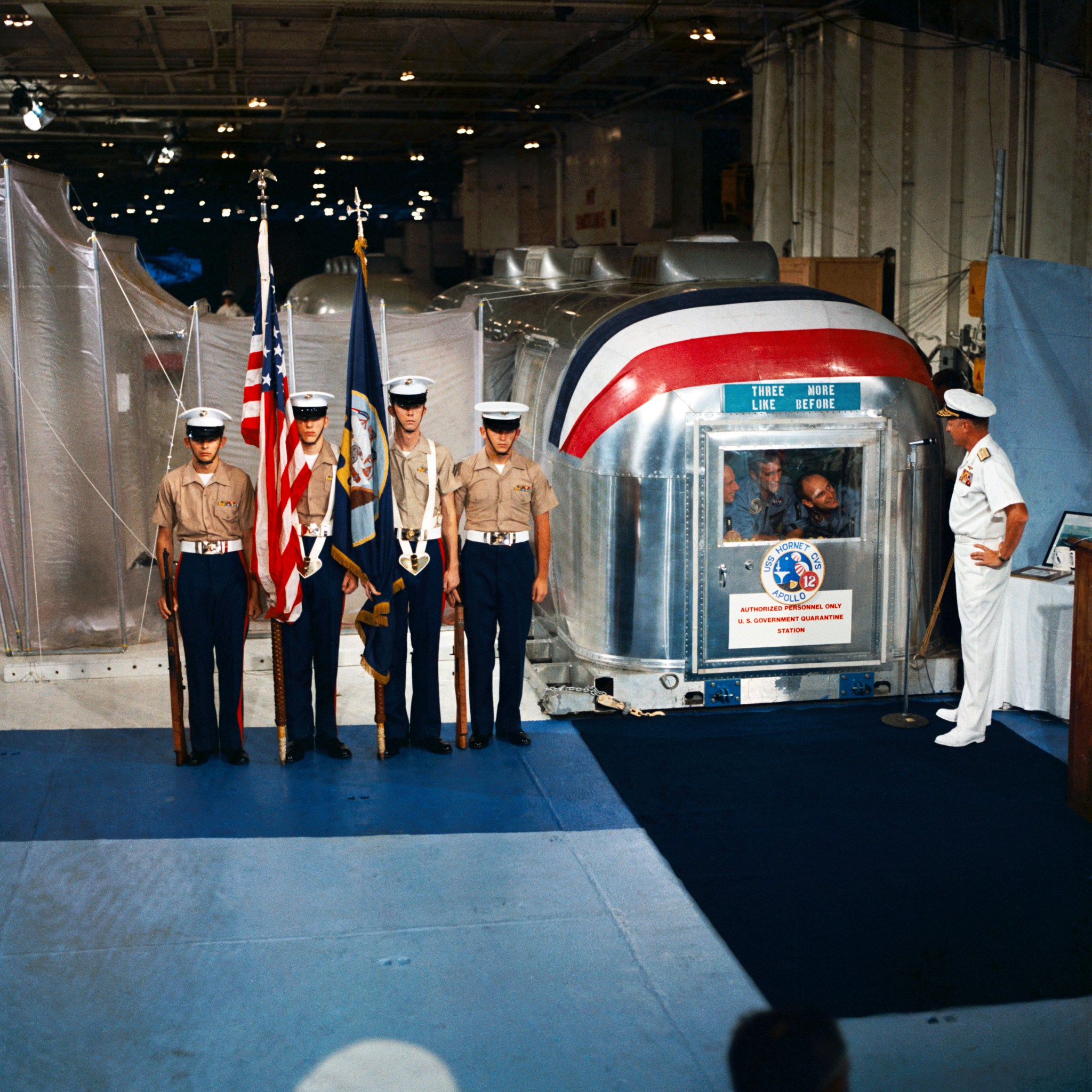
This week in 1969, Rear Adm. Donald C. David, commander of the Manned Spacecraft Recovery Force in the Pacific, welcomes the crew of the Apollo 12 lunar landing mission aboard the USS Hornet, prime recovery vessel for the mission. A color guard was also on hand for the welcoming ceremonies. Inside the Mobile Quarantine Facility are, from left, astronauts Charles Conrad Jr., commander; Richard F. Gordon Jr., command module pilot; and Alan L. Bean, lunar module pilot. The NASA History Program documents and preserves NASA’s remarkable history through a variety of products — photos, press kits, press releases, mission transcripts and administrators’ speeches. For more pictures like this one and to connect to NASA’s history, visit the History Program’s Web page.
Welding of Orion Spacecraft at Michoud Assembly Facility Featured on ‘This Week @NASA’
The welding of 3 cone panels of NASA’s Orion Spacecraft is featured in the latest edition of “This Week @NASA,” a weekly video program broadcast nationwide on NASA-TV and posted online.
Technicians at NASA’s Michoud Assembly Facility finished welding three cone panels to the pressure vessel of the Orion spacecraft crew module, currently scheduled to fly beyond the moon and back during the unmanned Exploration Mission 1 in 2018. The pressure vessel, which maintains a livable atmosphere when astronauts are aboard, is made of seven large aluminum pieces that must be welded together in detailed fashion. When the remaining pieces are welded on, Orion will be shipped to NASA’s Kennedy Space Center for processing and final preparations for its launch atop the Space Launch System, NASA’s next deep-space exploration rocket.
View this and previous episodes at “This Week @NASA” or at https://www.youtube.com/user/NASAtelevision.
Obituaries
P. Howell Taylor, 80, of Albertville, Alabama, died Nov. 10. He retired from the Marshall Center in 1993 as a contract specialist. He is survived by his wife, Ann Taylor.
Edward E. Martin, 83, of Huntsville, died Nov. 12. He retired from the Marshall Center in 1994 as an electronics technician. He is survived by his wife, Anne K. Martin.
James E. Rorex, 90, of Huntsville, died Nov. 12. He retired from the Marshall Center in 1980 as an aerospace engineer.
James C. Pentecost, 89, of Gallant, Alabama, died Nov. 15. He retired from the Marshall Center in 1989 as a construction representative. He is survived by his wife, Otho Pentecost.
William P. Baker, 92, of Fayetteville, Tennessee, died Nov. 18. He retired from the Marshall Center in 1988 as an aerospace engineer.
C. Bruce Thornhill, 79, of Arab, Alabama, died Nov. 19. He retired from the Marshall Center in 1997 as a computer engineer. He is survived by his wife, Gaynell Thornhill.
Wilma J. Selvidge, 80, of Fayetteville, Tennessee, died Nov. 21. She retired from the Marshall Center in 1985 as a personnel specialist.




























